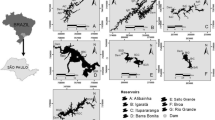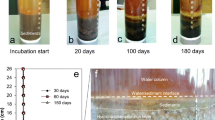Abstract
Surficial sediments and epilithic periphyton (biofilm) were sampled from six sites on the River Churnet and five sites on the River Manifold in Staffordshire and analysed for cadmium (Cd), copper (Cu), lead (Pb) and zinc (Zn). The sites demonstrated a wide range of sediment trace metal concentrations determined by inductively coupled plasma optical emission spectrometry (ICP-OES) and atomic absorbtion spectroscopy (AAS). Biofilm was removed from the substrate using physical abrasion and 0.005 M ethylenediaminoethanetetra-acetic acid (EDTA) extractant. The European Standards, Measurements and Testing Programmes (BCR) operationally defined geochemical speciation scheme was used to determine the exchangeable, acid soluble fraction of the sediments. Significant positive correlations were determined between the EDTA extractable biofilm and the exchangeable sediment fraction for Cd, Cu and Zn but not for Pb. Natural epilithic periphyton may be a potential metal biomonitor particularly of Cu, Cd and Zn in aquatic systems and provide supporting information in relation to potential sediment toxicity.
Similar content being viewed by others
References
Bertin, C. and Bourg, A.C.M.: 1995, Trends in the trace metal content (Cd, Pb, Zn) of river sediments in the drainage basin of smelting activities, Water Research 29, 1729-1736.
Chisholm, J.I., Charsley T.J. and Aitkinhead, N.: 1988, Geology of the Country Around Ashbourne and Cheadle, HMSO, UK.
Davidson, C.M., Ferreira, P.C.S. and Ure, A.M.: 1999, Some sources of variability in the application of the three-stage sequential extraction procedure recommended by the BCR to industrially contaminated soil, Fresenius Journal of Analytical Chemistry 363, 446-451.
Dawson, E.J. and Macklin, M.G.: 1998, Speciation of trace metals in floodplain and flood sediments: a reconnaissance survey of the Aire valley, West Yorkshire, Great Britain, Environmental Geochemistry and Health 20, 67-76.
Decho, A.W.: 1993, Methods for the observation and use in feeding experiments of microbial exopolymers, in: Kemp, P.F., Sherr, B.F., Sherr, E.B., Cole, J.J. (eds), Handbook of Methods in Aquatic Microbial Ecology, Lewis Publishers, London, pp. 685-694.
Dodd, J., Large, D.J., Fortey, N.J., Mildowski, A.E. and Kemp, S.: 2000, A petrographic investigation of two sequential extraction techniques applied to anaerobic canal mud, Environmental Geochemistry and Health 22, 281-296.
Fuchs, S., Haritopoulou, T., Scafer, M. and Wilhelmi, M.: 1997, Trace metals in freshwater ecosystems introduced by urban rainwater runoff-Monitoring of suspended solids, river sediments and biofilms, Water Science Technology 36, 277-282.
Gray, B.R. and Hill, W.R.: 1995, Nickel sorption by periphyton exposed to different light intensities, Journal of North American Benthological Society 14, 299-305.
Lowe, R.L., Guckert, J.B., Belanger, S.E., Davidson, D.H. and Johnson, D.W.: 1996, An evaluation of periphyton community structure and function on tile and cobble substrata in experimental stream microcosms, Hydrobiologia 328, 135-146.
Mesuere, K., Martin, R.E. and Fish, W.: 1991, Identification of copper contamination in sediments by a microscale partial extraction technique, Journal of Environmental Quality 20, 114-118.
Nies, D.H. and Silver, S.: 1995, Ion efflux systems in bacterial metal resistances, Journal of Industrial Microbiology 14, 186-199.
Porter, L. and Robey, J.: 2000, The Copper and Lead Mines Around the Manifold Valley, North Staffordshire, Landmark Publishing Ltd., Ashbourne, UK.
Quevauviller, P.: 1998, Operationally defined extraction procedure for soil & sediment analysis. 2. Certified Reference material, Trends in Analytical Chemistry 17, 633-642.
Rainbow, P.S.: 1995, Biomonitoring of trace metal availability in the marine environment, Marine Pollution Bulletin 31, 183-192.
Schorer, M. and Eisele, M.: 1997, Accumulation of inorganic and organic pollutants by biofilms in the aquatic environment, Water, Air, and Soil Pollution 99, 651-659.
Author information
Authors and Affiliations
Rights and permissions
About this article
Cite this article
Holding, K., Gill, R. & Carter, J. The Relationship between Epilithic Periphyton (Biofilm) Bound Metals and Metals Bound to Sediments in Freshwater Systems. Environmental Geochemistry and Health 25, 87–93 (2003). https://doi.org/10.1023/A:1021205101133
Issue Date:
DOI: https://doi.org/10.1023/A:1021205101133




